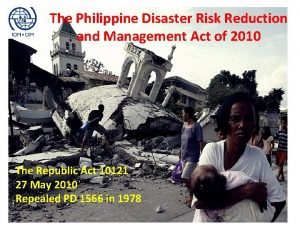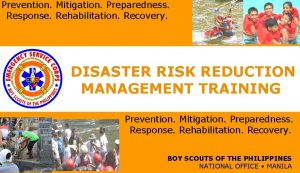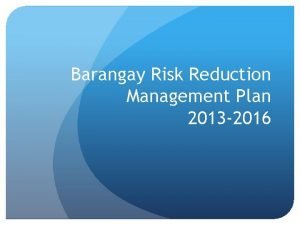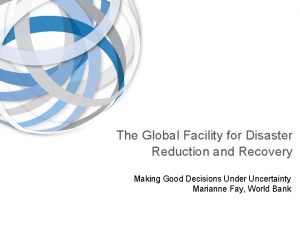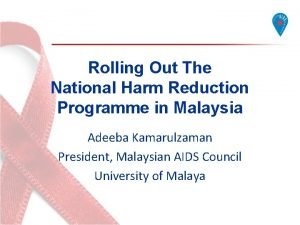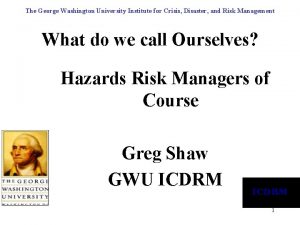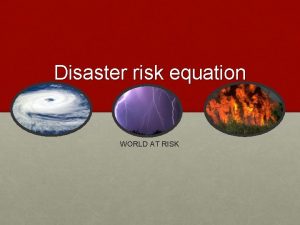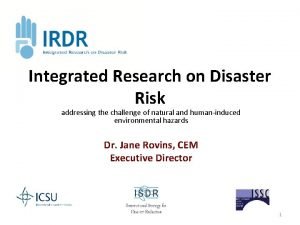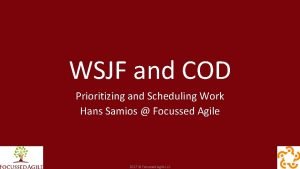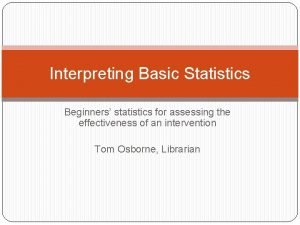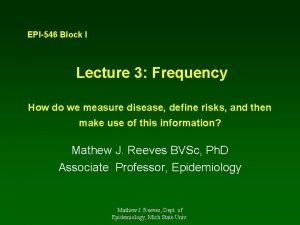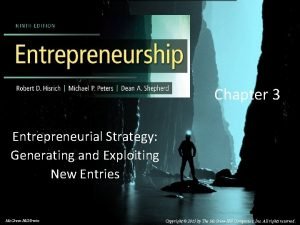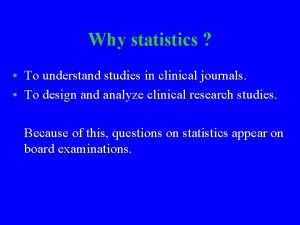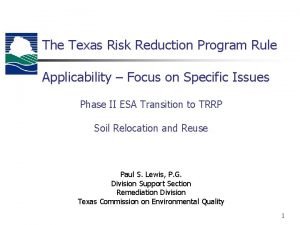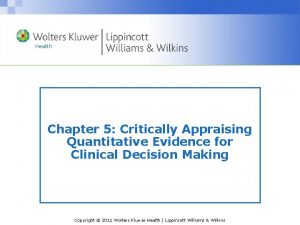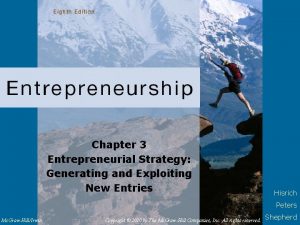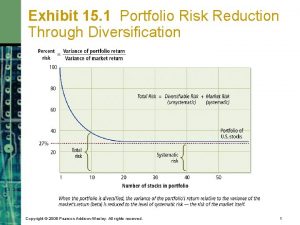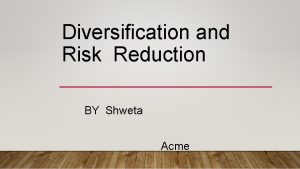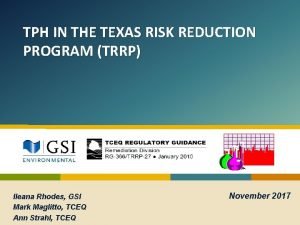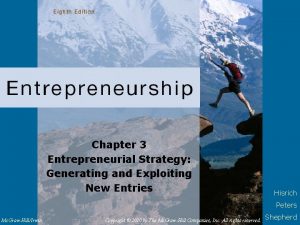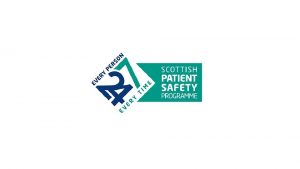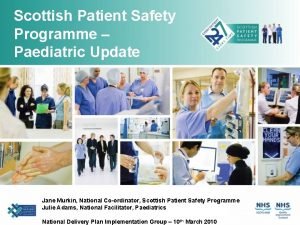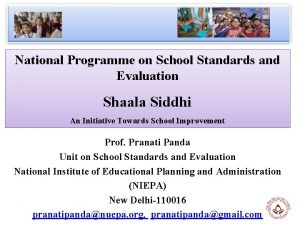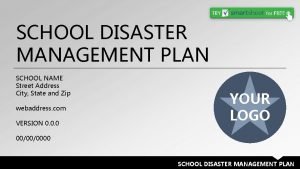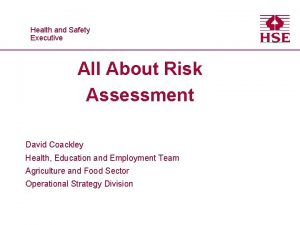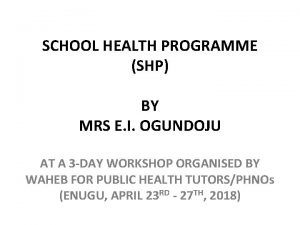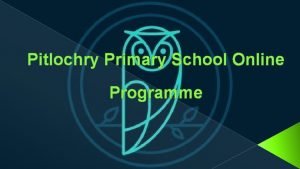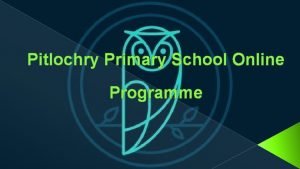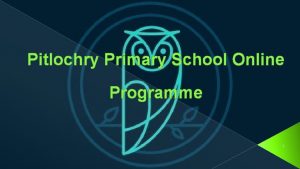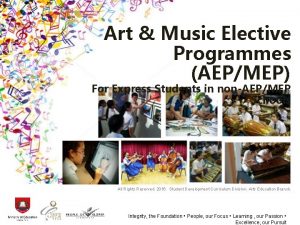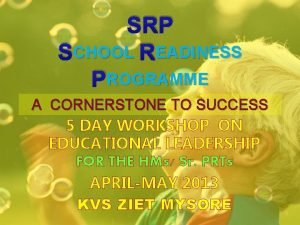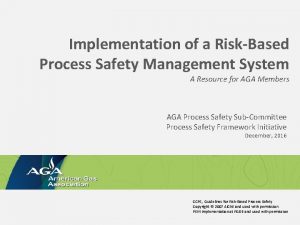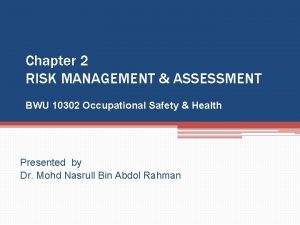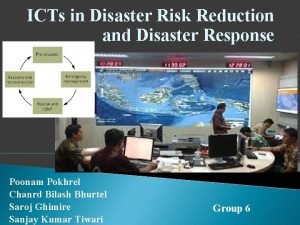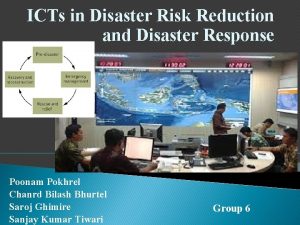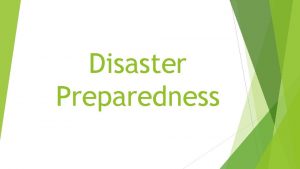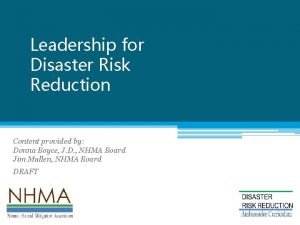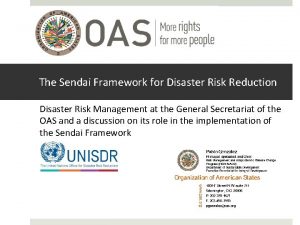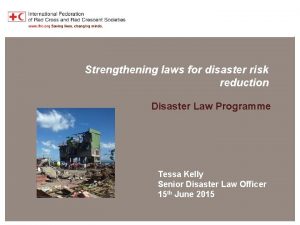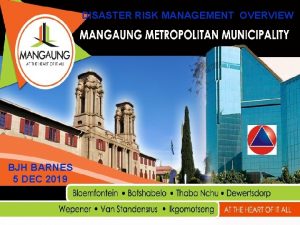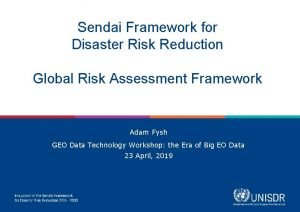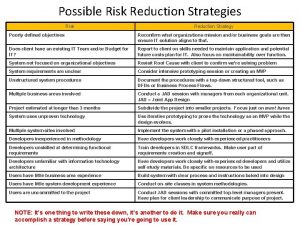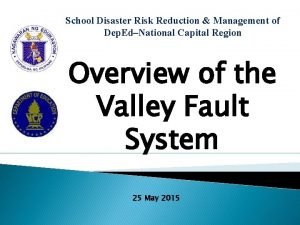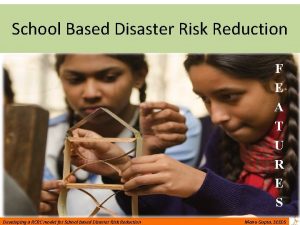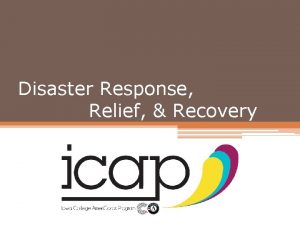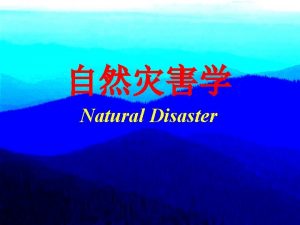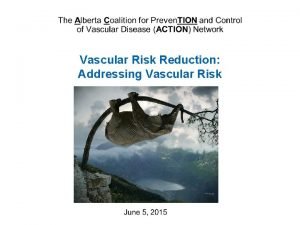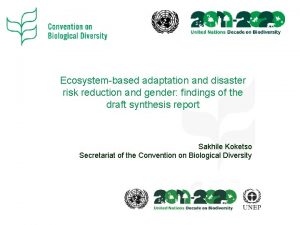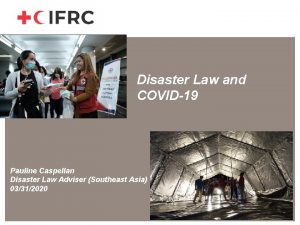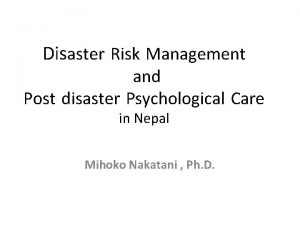GOIUNDP Disaster Risk Reduction Programme School safety and























































- Slides: 55

GOI-UNDP Disaster Risk Reduction Programme- School safety and Civil Defence j. radhakrishnan@undp. org

Contents

India’s vulnerability to disaster § Close to 60% land is vulnerable to earthquake § 70% land under cultivation is prone to drought § 40 million hectares of land is prone to floods and 8, 000 km coastline is vulnerable to cyclones § 12% government revenue spent on relief and rehabilitation § 2% GDP loss


Cloudburst in Leh –August 2010 - 200 deaths Kosi floods 2008, Cyclone Aila 2009 Earthquake, Gujarat 26 th January, 2001 Sikkim earthquake 2011 - Andhra, Karnataka floods 2009 Major Natural Disasters Tsunami, Tamil Nadu 26 th December, 2004

Changing approach to disaster management

KUMBAKONAM SCHOOL FIRE TRAGEDY- a case study of a real disaster On July 16 th, 2004 one of the worst fires in Indian history broke out in a school building housing three schools at Kumbakonam in Thanajvur district, India. 94 school children perished in the fire while 18 suffered injury.

Thousands of people thronging the fire accident site



VICTIMS • The students in the front class room escaped • Totally 75 students all belonging to 2 nd, 3 rd and 4 th standards were charred in the fire. • 37 students sustained serious burn injuries. • Only the three teachers and some students in that portion of the school could escape. • Out of the 37 students injured 19 more children succumbed to the burns at hospital.


Education Department after the fire • Schools that had thatched roofs have all been changed to pucca roof with nonflammable materials. • All the noon meal centres have been provided with nonflammable material roof. • All the schools have been provided with fire extinguishers.


Situation today • Court case is still pending • Supreme Court has directed all the state governments to file affidavits on school safety • DM in schools atleast in CBSE has been introduced • Institutional DM plans still are not a reality • People who lost their children are yet to fully recover


Lessons learnt from the school fire tragedy • Many districts do not have an operational live DM plan • The contingency plans also not updated • When approvals were given to the school nobody factored in the likely disasters • Public places safety act ignored during approval- one exit, noon meal under thatches • Development an issue • Psycho-social support a necessity • Need to have drills • Need to address all disasters • Need address underlying causes, not focus only on the post disaster efficiency

Changing role of Civil Defence



UNDP and disaster management- …from relief to managing and reducing disaster –

The Go. I-DRM/DRR programme in Education and Schools works towards Ø Capacity building of various stakeholders at all administrative level. Ø Environment building, education, awareness programmes and strengthening the capacity at all levels in natural disaster risk management and sustainable recovery Ø support and facilitate incorporation of Disaster Management in Education at school and Higher level by creating awareness and enabling environment

Why mainstream DRM in Education • Catching them young and building ‘agents of change’ • Reach to a large community of learners in an organized way. • Instutionalise the message of DRM • The multiplier effect of education. Eg: child/teacher to family etc. • Children more vulnerable as seen from disasters such as Kutch earthquake etc. • DM teaching is is more than education – it is a survival skill • It adds value to human consciousness • It is an exercise in to prepare the community for its own existence 23

Initiatives taken to reach the Objective under the DRM programme 24

Inclusion of DM in School Curriculum • Inclusion of DM in Class VIII, IX, X and XI (geography and Sociology) as part of the frontline curriculum by CBSE. • Disaster Management in all the State Board PARTNERS IN THE PROCESS? • CBSE • Directive of Ministry of Human Resource Development • Collaboration with UNDP • The support of Ministry of Home Affairs (MHA) • State Education Board 25

Challenges in including DRM in School Education The Resistance Syndrome!! • From academic community eg: where should it fit in, how much should we cover? • From school clientele eg: how to fit this within the growing syllabus, limited knowledge of subject etc. • From parents eg: additional load on children etc. 26

A safe school is one which is located in a hazard free area and behaves well both structurally and non- structurally safe when a hazard strikes. Structural Safety Damage to school buildings in Katchal Non Structural Safety In this chemistry laboratory, unsecured glass containers broke when they fell from the table and through open cabinet doors 27

Three Possible ways of Intervention in schools and education

CURRICULAR • Infusion: Infusion of disaster and its related components in the existing text books with proper relevance. • Example sighting: Teacher can sight example based upon locale specific disasters so that students can get interest to learn the various concepts related with disasters. • Training & capacity building: A set of training modules can be devised to equip the teachers, school administration and specifically the students with a view to develop their capacity in relation to disaster. • Demonstration: Demonstration through visuals, maps in the classroom during teaching.

CO-CURRICULAR • Casual games in the class room related with lesson learnt in the classroom. • Newspaper clipping collection. • Quiz, drawing, caption competition. • Experience sharing. • Exposure visit. • Live demonstration. • Raising of emergency fund. • Observance of NDRD & other days. • Formation of different TASK FORCES among teachers & students such as, search & rescue, first aid, etc.

EXTRA-CURRICULAR • • • Rally. Awareness campaign. Sensitization workshop. Linking up of Eco-Club with disaster management activities. Chart, hand-outs, posters preparation & distribution. Hoardings, pamphlets. Taking pledge. Community mobilization through small. project/initiatives by the school children. Meeting with parents/home visits.

Promoting Awareness & Education Activities Hand in Hand - School Children form a human chain around Dighalipukhuri in Guwahati. In the picture: (left) Sensitization programme on safety aspects for children in the NCC camp; (right) student getting down from the upper floor in an evacuation drill conducted in Kendriya Vidyalaya Rajkot.


Colouring Activity Book

Demonstrating Disaster Risk Management Focus areas: § Acquire skills in many aspects (demonstrate through simulated mock drills) § Hazard hunt activity in schools and other simple exercises §Preparation of a Building Evacuation Plan for various hazards § School Disaster Management Plan / Building Level Emergency Response Plan §Simple structural and non-structural mitigation measures

School Building – Mexico Earthquake

Drop Cover Hold in Practice Dhanbad Bokaro Fire Safety measures demonstrated by the Fire Department

Training and Capacity Building Focus areas: § Training workshops for key people in education department, teachers/students and members of the School Safety Advisory Committee in DM. § Conduct training in First aid, Fire fighting, Search & Rescue, School Plan making etc followed by Preparedness Emergency Drills. § Training of various teams in the schools. Training workshop for Teachers - Dhanbad Rescue operation - from top floor of the building – Mangalore district

Preparation of School DM plans 39

Management Structure for School Awareness and Safety Programme and plans

Guiding Principles for School DM Planning 41

Steps for preparation of DM Plans 42

Deputy Director Education – Inaugural Session Presentation by DM Faculty ATI (ILM) Presentation by expert on geology related hazards Session by Fire and Rescue Services

Introduction Purpose Principles for the Planning Process Sequence adopted for Planning Process The Plan need to address a range of events and hazards caused both by both nature and by people, such as: - Natural Disasters (earthquakes, cyclones, floods etc) -Weather related – Fire - Chemical Accident - Stampede/ Crowd incident - Civil Disturbance - Medical Emergencies - Explosive/Bomb Threat - School Bus Accident - Hostage/Kidnapping - Act of terror or war -Others as determined by the District School Safety Team Section I: General Considerations and Planning Guidelines Section II: Risk Reduction: Prevention/Mitigation Section III: Preparedness Section IV: Response Section V: Recovery

Actions that schools should take under each of these areas include: - Prevention/Mitigation addresses what can be done to reduce or eliminate risk to life and property - Preparedness focuses on the process of planning for the worst-case scenario. - Response is devoted to the steps to take during an emergency - Recovery deals with how to restore the learning and teaching environment after a crisis Using this Sample Outline for Building Level Emergency Preparedness and Response Plan Good plans are never finished. They can always be updated based on experience and changing vulnerabilities and assessment of current capabilities.

Evacuation Plan of NC Jindal School 46


Mainstreaming DRR in CD -What more can Civil Defence do in addition to the current support for Disaster Management? • Support in School and Community level Contingency Planning • Help in Recovery Planning to recover and build better resilient community (build back better) • Become a potent social mobilizer for mainstreaming Disaster risk reduction in lives and livelihood • Undertake activities to create awareness and sensitize the masses about hazards and their impact • Initiate or support programs to reduce vulnerabilities and risks • Facilitate safety and awareness programmes in educational institutions

Your possible role • Facilitating organization of trainings or sensitization of teachers. • Facilitating the preparation of Disaster Management Plans in schools as local volunteers • Link stakeholders with information and resources for mainstreaming DRM in Education. 49


Field level challenges in Disaster Management

Field level challenges in Disaster Management-contd. .

Way Forward

One could go on and on but to end this I would reiterate – “A stitch in time. . . . ” • “Onus is on us” – let’s assume responsibility • Let us make disaster planning a “state of mind” • Incorporate socio-economic impact of calamities into the planning process and livelihood patterns from the community levels in a bottom up approach • Develop risk management model to reduce exposure to disasters at family, community and state levels. • Let us upport emergency planning as it spells difference between “flourishing” or “perishing” And Let all of us join together and Strike Before Disaster Does!-

Thank You krith_72@yahoo. com j. radhakrishnan@undp. org
 Philippine disaster reduction and management act
Philippine disaster reduction and management act Republic act 10121
Republic act 10121 Barangay disaster risk reduction management plan
Barangay disaster risk reduction management plan Risk reduction vs risk avoidance
Risk reduction vs risk avoidance Socio economic trends
Socio economic trends Market risk assessment
Market risk assessment Harm reduction programme
Harm reduction programme George washington crisis management
George washington crisis management Disaster risk equation explained
Disaster risk equation explained Integrated research on disaster risk
Integrated research on disaster risk Wsjf values
Wsjf values Absolute risk reduction
Absolute risk reduction Relative risk reduction
Relative risk reduction Risk reduction strategies for new entry exploitation
Risk reduction strategies for new entry exploitation Relative risk reduction formula
Relative risk reduction formula Trrp-2
Trrp-2 Absolute risk formula
Absolute risk formula Risk reduction strategies for new entry exploitation
Risk reduction strategies for new entry exploitation Receivables finance risk reduction
Receivables finance risk reduction Risk reduction through diversification
Risk reduction through diversification Risk reduction through diversification
Risk reduction through diversification Trrp guidance
Trrp guidance Risk reduction strategies for new entry exploitation
Risk reduction strategies for new entry exploitation Essentials of safe care
Essentials of safe care Scottish patient safety programme
Scottish patient safety programme A safety programme consists of how many e's
A safety programme consists of how many e's Building safety programme monthly data release
Building safety programme monthly data release Shaala siddhi mission statement
Shaala siddhi mission statement Residual risk and secondary risk pmp
Residual risk and secondary risk pmp Business risk vs financial risk capital structure
Business risk vs financial risk capital structure Relative risk
Relative risk Attributable risk
Attributable risk School disaster recovery plan
School disaster recovery plan Health and safety risk assessment template
Health and safety risk assessment template Aims of school health programme
Aims of school health programme Pitlochry primary school
Pitlochry primary school Pitlochry primary school
Pitlochry primary school Minus type desk
Minus type desk Pitlochry primary school online programme
Pitlochry primary school online programme Tattletooth program
Tattletooth program Music elective programme (secondary school)
Music elective programme (secondary school) Pitlochry primary school online programme
Pitlochry primary school online programme School readiness programme in kvs
School readiness programme in kvs Risk projection
Risk projection Absolute risk vs relative risk
Absolute risk vs relative risk Inherent risks examples
Inherent risks examples Absolute risk vs relative risk
Absolute risk vs relative risk Activity sheet 1 about p/e ratios answer key
Activity sheet 1 about p/e ratios answer key Risk classification
Risk classification Risk financing adalah
Risk financing adalah The biggest risk is not taking any risks
The biggest risk is not taking any risks Key risk indicators for vendor management
Key risk indicators for vendor management Ir x cr x dr
Ir x cr x dr Risk map
Risk map Risk based safety management system
Risk based safety management system Hierarchy risk assessment
Hierarchy risk assessment
